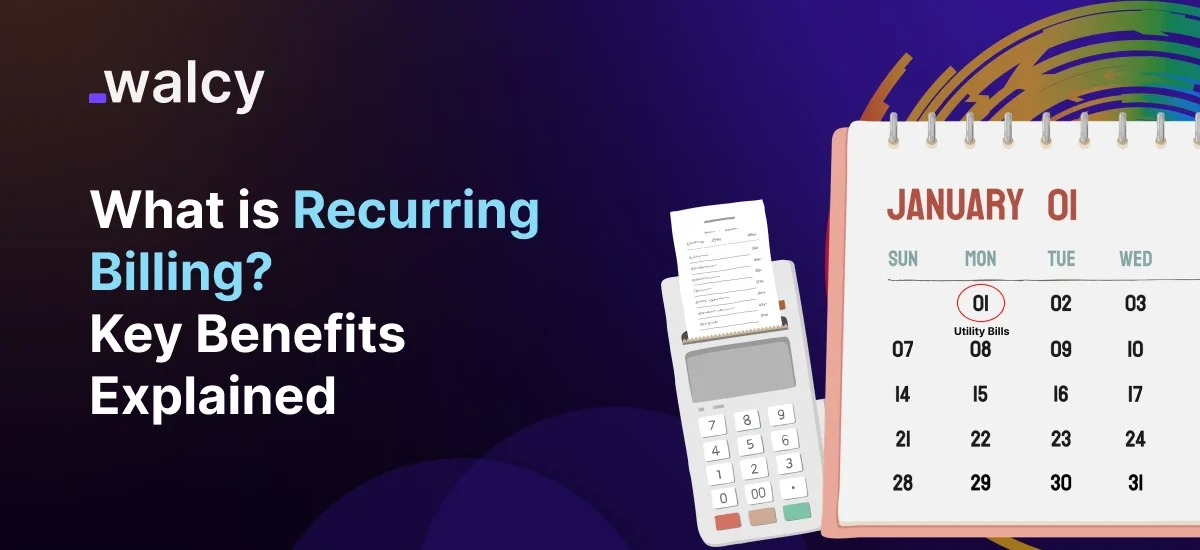Recurring billing is a model of payment whereby an organization charges for goods or services rendered to customers periodically, often month-to-month or year-over-year. Large enterprises that offer subscription-based services, such as online streaming services, SaaS providers, and gyms, all use this system. Unlike one-time payments, recurring billing enables a customer to be continuously provided with a service or product, as long as the customer stays current with the payments.
Understanding Recurring Billing
Recurring billing empowers organizations to handle payments more efficiently, as charges can be automated for continuous revenues. In the recurring payment model, the periodic billing of the customer’s credit card or bank account may be on a month-on-month or year-on-year basis. This means there is no need to have customers manually fulfill the transaction; hence, more convenient both for the business and its clients. The automation also cuts errors and delays, allowing timely payments that contribute to predictable cash flow.
Continuous billing plays at the core of the approach towards long-term customer relationships in the sense that it provides grounds whereby service is never cut off. Customers are thus much aware because recurring invoices regularly carry on charges for particular services, thereby avoiding “surprise” charges. For businesses, the merits are administration reduction and increased customer satisfaction arising out of seamless service delivery.
How Does the Recurring Payment System Work?
The recurring payment system works on the premise of securely storing customer details about payments and then charging customer accounts at regular intervals, such as monthly and yearly. Once a customer subscribes or becomes a member, his information about payments is encrypted and safely stored in the system.
From this point on, everything rests on the recurring billing system, which ensures the payments will be handled efficiently without the need for either the customer or the business to get directly involved. In a subscription service, once the customer completes a sign-up process, then the system will automatically handle all future payments after the end of each billing cycle.
Generally speaking, the process behind this system is pretty simple and effective. The sign-up involves the details of payment from customers; then comes automated billing, which bills the account of the customer at scheduled periods. At the end of such a transaction, the system generates recurring invoices, which are sent to the customer for proof of payment, for transparency, and so the customer may keep track of his or her payments.
These regular payments finally guarantee continuity of service, whereby the customers can enjoy uninterrupted access to their subscribed products or services, as long as their payments are up-to-date. The smoothness of this process not only contributes to customer satisfaction but also helps companies generate predictable revenue streams continuously.
What Types of Businesses Use Recurring Billing?
Many industries are using recurring billing as a means of creating more predictable revenue streams while offering customers a convenient payment experience. Following are some of the frequent business models for using this approach:
Subscription Services:
These include providers like Netflix, Spotify, and others in the entertainment industry. The subscription fee keeps them running to provide access to their libraries of movies, music, or shows. They are charged on a monthly or yearly basis in advance for continuous retention of their services with them, with no need for manual intervention. This model is also appealing to users due to its convenience and flexibility regarding cancellation or upgrades at any time.
SaaS:
Companies such as Microsoft 365, Salesforce, and Adobe use recurring billing for their tools. Instead of buying the software outright, customers subscribe to the services that are offered, allowing them to access cloud storage, data analysis, and even collaboration tools on a monthly or yearly basis. This model allows businesses to maintain updated software and creates an ongoing relationship with customers through upgrades of service.
Health and Fitness:
Normally, recurring billing management is done in membership subscription-based fitness studios, gyms, and wellness platforms. The members are charged every month to allow the facilities continuously to make available workout facilities, classes, or personal training sessions. This model helps the business manage cash flow by providing members with an ongoing seamless membership.
Utilities and Telecommunications:
These companies sell primary day-to-day services such as electricity, water, internet access, cell phone plans, etc. Most companies will have periodic, recurrent charges whereby they bill customers on either an ‘as-used’ basis or fixed plans. This would be monthly or quarterly, but as discussed, recurring billing maintains the continuity of service for such vital facilities to the client. This automated recurring ensures customers do not fall into the chances of having these services discontinued over missed or late payments.
E-learning and Online Courses:
Online learning platforms, such as Coursera, MasterClass, or LinkedIn Learning, use recurring payments for classes or certifications. Learners subscribe to these services and pay some periodic charge for access, video tutorials, and certifications. It extends continuous access to educational content so customers can advance their skills over time.
Subscription Box Services:
This is generally when companies Shave Club, Birchbox, and Blue Apron create subscription box deliveries regularly for everything from grooming products to meal kit delivery. Generally, customers are charged regularly for products curated and shipped to their doors. This subscription model offers convenience and carries an element of surprise behind it, which appeals most to those who enjoy getting products regularly.
Types of Recurring Charges
Recurring charges are varied and can differ greatly by the nature of the service or product supplied. The following are the most common types:
Fixed Recurring Charges:
These represent fixed sums, charged regularly monthly, or annually, without change. Typical examples of these include membership in a gym, online streaming services, or license fees for some software products. It makes budgeting easy for the customers and gives predictable revenues to the business. Fixed charges are easy to manage and hence less cumbersome for the parties.
Variable Recurring Costs:
The costs vary with the degree of usage or consumption. Common examples are utility bills, which vary with use, and mobile phone plans charging with every amount of data consumed or minutes used. Variable charges provide the customer with the flexibility to pay only according to consumption, and this is difficult to anticipate and budget in advance.
Hybrid Recurring Charges:
These contain elements of both fixed and variable charges. A good example would be a subscription that includes some sort of base fee for standard access but extra for premium features, additional data, or overage usage. This model ensures a base level of service provided at a predictable cost, with the ability for customization and flexibility based on the customer’s needs or use pattern. Hybrid charges can also let the customers be satisfied with customized fitted solutions and provide some degree of revenue predictability for the business.
Advantages and Disadvantages of Recurring Billing Management
Advantages
Predictability of Revenue: Efficient recurring billing guarantees assured periodic revenue intake, hence assisting an enterprise in forecasting future revenues with greater certainty. Predictability presents clear financial planning and budgeting for correct resource allocation and further strategy formulation.
Customer Convenience: Subscription payment automation decreases the chances of missed payments and assurance of continuous service to the customer. This convenience will improve customer satisfaction and may affect their loyalty since customers will not need to remember to make manual payments every billing cycle.
Operational Efficiency: Automating the billing process saves both resources and time spent in this process by any business. It cuts down manual errors and administrative burdens, furthering operational efficiency to make sure that timely payments maintain a smooth and reliable billing process.
Improved Customer Retention: Continuous billing models can build long-term customer relationships and may reduce churning. Subscribers are more likely to stay with ongoing service, where they have seamless access uninterrupted, thus it tends to promote ongoing customer loyalty.
Disadvantages
Difficulty in managing complex billing: The high volume of regular invoices and their timely collections always pose problems, especially when the charges are variable. Managing different billing schedules and charge types adds complexity to the system, which may stress administrative resources.
Customer dissatisfaction: If there are some errors related to the recurring payment system or issues that concern the management of recurring billing, it may lead to disputes in billing or dissatisfaction with customers. These misunderstandings or mistakes in charges undo the relationship between the customer and the service provider, which again requires additional effort and manpower to resolve.
Failures in Payments: Recurring payments are dependent upon timely information about the customer. Expired credit cards, or an account balance too low to cover the payment, lead to disruptions in services. Keeping payment information current and re-processing failed transactions is an inefficient process that disrupts service.
Conclusion
In today’s digital economy, recurring billing has become a major lifeline for businesses seeking to stabilize their income streams and improve customer experience. By deploying an automated recurring payment system, a company will have the benefits of predictable income and reduced administrative overhead. This service simplifies financial planning for businesses, while customers get uninterrupted services, thereby reinforcing satisfaction and long-term loyalty.
The recurring billing facility has its share of problems to address. Companies should not forget that a lot of complexity about recurring billing management needs critical attention: an enormous number of invoices is to be processed, and problems such as payment failures need special attention.
Efficiency and error-free performance will be essential for retaining customer confidence and successful operational outcomes. In the end, effective recurring billing is always about strategy in how one balances the consistency of revenue with the satisfaction of customers so that all parties benefit from the experience.
Read about: All About Overseas Payments (2024); Comprehensive Guide



